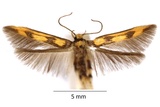Stathmopoda pedella (Linnaeus, 1761) Species
Last modified: Nov. 25, 2025, 8:02 p.m.
A common species found in most areas of Belgium, especially in the northern part. Mostly observed as single individuals.
Details
- Classification
- Family: Stathmopodidae > Genus: Stathmopoda > Species: Stathmopoda pedella
- Vernacular names
- Pootmot (NL), Balancierstabmotte (DE)
- First mention in Belgium
- De Fré Ch. 1858. Catalogue des Microlépidoptères de la Belgique. — Annales de la Société entomologique belge 2: 45–162. On page 148 (as C.[osmopteryx] Pedella. L.). view page
- Status
-
Native
Distribution
Caterpillar
Short, stout and spindle-shaped, purplish brown; head capsule and prothoracic plate dark brown.
Cocoon/pupa
A very flimsy cocoon on the ground, some earth particles are used to camouflage it.
Bionomics
The egg is oviposited near or on the fruit of the foodplant. Feeding evidence is hardly noticed, just a small hole and some frass protruding from the fruit. Full-grown larvae leave the fruit and drop to the ground in September.
Pupation between leaf litter on the ground. The species hibernates in the pupal stage.
Adults rest during the day in the foliage or on tree trunks and sometimes come to light.
Typical resting position on its fore and mid legs, but with the hind legs turned slightly forwards and upwards. These hind legs possess strong spurs and are coloured in the same yellow and dark brown as the wings, possibly aiming to mimic a wasp-like hymenopteran or a thorn-like structure for defense.
Flight periods
One generation a year from mid-June till the end of August.
Observed on
- Host plant (species):
- Alnus glutinosa
The larva lives in the fruits of Alnus glutinosa.
Habitat
Rather moist environments wherever Alnus grows.






